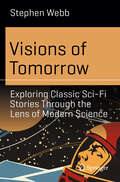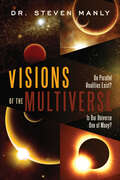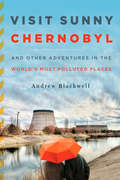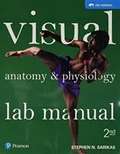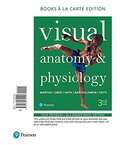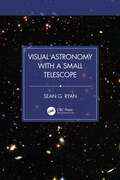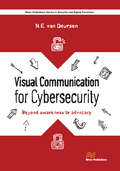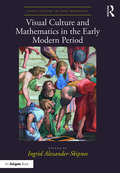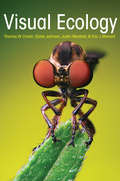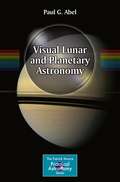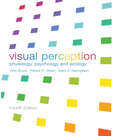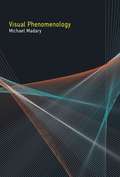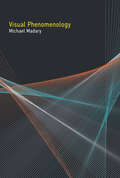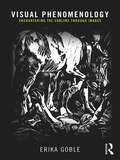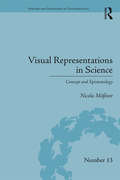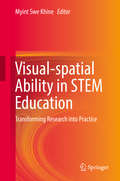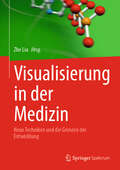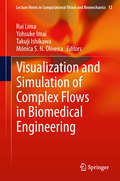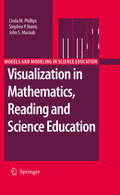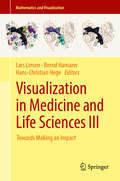- Table View
- List View
Visions of Lost Worlds: The Paleoart of Jay Matternes
by Matthew T. Carrano Kirk R. JohnsonA lavish showcase of paleoartist Jay Matternes's spectacular murals and sketchesFor half a century, the artwork of Jay Matternes adorned the fossil halls of the Smithsonian National Museum of Natural History. These treasured Matternes murals documenting mammal evolution over the past 56 million years and dioramas showing dinosaurs from the Mesozoic Era are significant works of one of the most influential paleoartists in history. Simultaneously epic in size and scope and minutely detailed, they also provide a window into the study and interpretation of vertebrate paleontology and paleoecology. Visions of Lost Worlds presents these unparalleled works of art, and also includes the sketches and drawings Matternes prepared as he planned the murals. Known for his technical genius and eye for detail, Matternes sketched from skeletons in museum collections and added muscle, skin, and fur to bring mammals and dinosaurs from prehistory to vivid life. This book offers a close look at these works of art, a peek inside the artist's process, and an examination of the works' impact and legacy.
Visions of Science: Books and Readers at the Dawn of the Victorian Age
by James A. SecordThe first half of the nineteenth century witnessed an extraordinary transformation in British political, literary, and intellectual life. There was widespread social unrest, and debates raged regarding education, the lives of the working class, and the new industrial, machine-governed world. At the same time, modern science emerged in Europe in more or less its current form, as new disciplines and revolutionary concepts, including evolution and the vastness of geologic time, began to take shape. In Visions of Science, James A. Secord offers a new way to capture this unique moment of change. He explores seven key books--among them Charles Babbage’s Reflections on the Decline of Science, Charles Lyell’s Principles ofGeology, Mary Somerville’s Connexion of the Physical Sciences, and Thomas Carlyle’s Sartor Resartus--and shows how literature that reflects on the wider meaning of science can be revelatory when granted the kind of close reading usually reserved for fiction and poetry. These books considered the meanings of science and its place in modern life, looking to the future, coordinating and connecting the sciences, and forging knowledge that would be appropriate for the new age. Their aim was often philosophical, but Secord shows it was just as often imaginative, projective, and practical: to suggest not only how to think about the natural world but also to indicate modes of action and potential consequences in an era of unparalleled change. Visions of Science opens our eyes to how genteel ladies, working men, and the literary elite responded to these remarkable works. It reveals the importance of understanding the physical qualities of books and the key role of printers and publishers, from factories pouring out cheap compendia to fashionable publishing houses in London’s West End. Secord’s vivid account takes us to the heart of an information revolution that was to have profound consequences for the making of the modern world.
Visions of Tomorrow: Exploring Classic Sci-Fi Stories Through the Lens of Modern Science (Science and Fiction)
by Stephen WebbThis anthology invites readers to revisit twelve timeless stories from visionary authors while pondering the scientific advancements they foreshadowed, making it ideal for fans of both science fiction and science. In Algernon Blackwood’s A Victim of Higher Space, the concept of extra spatial dimensions is explored, while Miles J. Breuer’s The Gostak and the Doshes examines time as a dimension in relativity. Stanley Waterloo’s Love and a Triangle touches on efforts to communicate with extraterrestrial intelligence, and Max Adeler’s The Fortunate Island raises questions about humanity’s readiness for first contact with alien life. Machine learning and AI feature in Edward L. Sabin’s The Supersensitive Golf Ball, while Saki’s Filboid Studge explores targeted advertising’s transformation through AI. Edward Bellamy’s With the Eyes Shut predicts devices like smartphones and sparks discussions on the future of scientific publishing. G.K. Chesterton’s The Tremendous Adventures of Major Brown delves into augmented, virtual, and mixed reality technologies. Edgar Wallace’s The Black Grippe provides a historical lens on pandemics and communication of scientific uncertainty. J. Arbuthnot Wilson’s PAUSODYNE looks at suspended animation and modern cryonics, while Edgar Allan Poe’s The Facts in the Case of M. Valdemar tackles advances in medical technology and definitions of death. Finally, Guy de Maupassant’s The Horla explores the potential for humanity to be supplanted by new life forms.
Visions of the Multiverse
by Steven Manly“[Manly] has succeeded in creating a succinct introduction to multiple universes within the historic context of theoretical physics.” —Foreword ReviewsThe idea of a multiple universe reality is no longer considered speculative or implausible by many physicists; rather, it is deemed inescapable. Distinct concepts of the multiverse spring from quantum mechanics, cosmology, string theory-based cosmology, and ideas about a mathematics-based reality that borders on the religious.In this accessible and entertaining book, Dr. Manly guides you on a tour of the many multiverse concepts and provides the non-technical background to understand them.Visions of the Multiverse explores questions such as:Just what is a multiverse?What are the different concepts of the multiverse and how are they related?Is it possible to determine if we live in a multiverse . . . or even in multiple types of multiverses?How do religious concepts of the afterlife and popular ideas based on the Law of Attraction relate to the scientific visions of the multiverse?Dr. Manly discusses a wide variety of fascinating concepts from relativity and the fundamental particles and forces of nature to dark matter, dark energy, and quantum mechanics in an unintimidating and conversational tone.Is humanity in the midst of a new Copernican revolution? You decide.
Visit Sunny Chernobyl: And Other Adventures in the World's Most Polluted Places
by Andew BlackwellFor most of us, traveling means visiting the most beautiful places on Earth—Paris, the Taj Mahal, the Grand Canyon. It's rare to book a plane ticket to visit the lifeless moonscape of Canada's oil sand strip mines, or to seek out the Chinese city of Linfen, legendary as the most polluted in the world. But in Visit Sunny Chernobyl, Andrew Blackwell embraces a different kind of travel, taking a jaunt through the most gruesomely polluted places on Earth. From the hidden bars and convenience stores of a radioactive wilderness to the sacred but reeking waters of India, Visit Sunny Chernobyl fuses immersive first-person reporting with satire and analysis, making the case that it's time to start appreciating our planet as it is—not as we wish it would be. Irreverent and reflective, the book is a love letter to our biosphere's most tainted, most degraded ecosystems, and a measured consideration of what they mean for us. Equal parts travelogue, expose, environmental memoir, and faux guidebook, Blackwell careens through a rogue's gallery of environmental disaster areas in search of the worst the world has to offer—and approaches a deeper understanding of what's really happening to our planet in the process.
Visual Anatomy & Physiology Lab Manual, Pig Version
by Stephen SarikasVisual Anatomy & Physiology Lab Manual (Stephen Sarikas) brings all of the strengths of the revolutionary Visual Anatomy & Physiology textbook (Martini/Ober/Nath/Bartholomew/Petti) to the lab. The 2nd Edition builds upon the visual approach and modular organization with new features to better prepare you for lab, maximize yout learning, and reinforce important concepts. With an emphasis on clear, easy to follow figures (from the Martini Visual A&P text),frequent practice, and helping you make connections, the manual provides you with the powerful tools you need to excel. <P><P>The two-page lab activity modules seamlessly integrate text and visuals to guide you through lab activities—with no page flipping. Lab practice consists of hands-on activities and assignable content in Mastering ™ A&P, including new pre-lab quizzes, Review Sheets, and virtual lab study tools.
Visual Anatomy And Physiology
by William Ober Kevin Petti Frederic Martini Judi Nath Edwin BartholomewFor courses in Two-Semester A&P. <P><P> Using Art Effectively with the Most Visual Approach to A&P <P><P> Visual Anatomy & Physiology combines a one-of-a-kind visual approach with a modular organization that uniquely meets the needs of today’s students—without sacrificing the comprehensive coverage of A&P topics required for careers in nursing and other allied health professions. <P><P> The 3rd Edition presents key new features based on recent research about how information is used and digested. New modules in the first chapter emphasize how to use art effectively when studying; new Integrated Figure Questions increases the likelihood you will spend time viewing the art and prompts you to consider what you have just learned; and new SmartArt Videos, accessible via QR code in the book,help in navigating key, complex pieces of art on some of the toughest topics. <P><P> New Interactive Physiology 2.0 tutorials, SmartArt Video Activities, and a mobile-friendly eText expand the options for students to use Mastering ™ A&P as an effective practice and learning tool. Also available with Mastering A&P <P><P> Mastering™ A&P is an online homework, tutorial, and assessment program designed to engage students and improve results. Instructors ensure that students arrive ready to learn by assigning educationally effective content before class, and encourage critical thinking and retention with in-class resources such as Learning Catalytics™. Students can further master concepts after class through assignments that provide hints and answer-specific feedback. With a wide range of activities available, students can actively learn, understand, and retain even the most difficult concepts.
Visual Anatomy And Physiology
by William Ober Kevin Petti Frederic Martini Judi Nath Edwin BartholomewVisual Anatomy & Physiology combines a one-of-a-kind visual approach with a modular organization that uniquely meets the needs of today’s students–without sacrificing the comprehensive coverage of A&P topics required for careers in nursing and other allied health professions. The 3rd Edition presents key new features based on recent research about how students use and digest visual information. New modules in the first chapter emphasize how to use art effectively when studying; new Integrated Figure Questions increases the likelihood that students will spend time viewing the art and prompts them to consider what they have just learned; and new SmartArt Videos, accessible via QR code in the book,help students navigate key, complex pieces of art on some of the toughest topics. New Interactive Physiology 2.0 tutorials, SmartArt Video Activities, and a mobile-friendly eText expand the options for students to use Mastering™ A&P as an effective practice and learning tool.
Visual Astronomy with a Small Telescope
by Sean G. RyanThis is a practical guide to using a small astronomical telescope of a size that corresponds to most “first” telescopes – around 75-150 mm, i.e. 3-6 inches, in diameter.Visual Astronomy with a Small Telescope is for people who are sufficiently interested in astronomy to have purchased a small telescope or received one as a gift, but who are still developing experience of using one. They may have looked at the Moon and major planets and be wondering, “What's next?” There are many books catering for casual star-gazing and many more advanced books dealing with astrophotography and astrophysics, but this is for someone who has acquired their first telescope or soon will and wants to make the most of it.It explains how the optics of the telescope function, so the reader understands what their telescope can do and how eyepieces should be selected and used depending on the type of object being observed. It details different types of astronomical objects, their astrophysical significance, and how to observe them. It contains 43 detailed, clear charts and describes 380 objects suitable for visual observation with a small telescope and explains how to locate them without needing a computer-controlled telescope. It will help readers make the most of their telescopes to successfully observe the Universe and kick-start a life-long interest in star-gazing.• Presents essential information on optics, astronomy and astrophysics for anyone with a small telescope. • Contains 43 detailed charts, based on the constellations and showing stars down to magnitude 8.5, and identifies 380 objects suitable for visual observation with a small telescope. • Written by a Professor of Astrophysics with experience as both an amateur astronomer and a professional observational astronomer using telescopes at both small and major observatories around the world.
Visual Communication for Cybersecurity: Beyond Awareness to Advocacy
by Nicole van DeursenCybersecurity needs a change in communication. It is time to show the world that cybersecurity is an exciting and diverse field to work in. Cybersecurity is not only about hackers and technical gobbledygook. It is a diverse field of work with a lot of collaboration with other disciplines. Over the years, security professionals have tried different awareness strategies to promote their work and to improve the knowledge of their audience but without much success. Communication problems are holding back advances in in the field.Visual Communication for Cybersecurity explores the possibilities of visual communication as a tool to improve the communication about cybersecurity and to better connect with non-experts. Visual communication is useful to explain complex topics and to solve complex problems. Visual tools are easy to share through social media and have the possibility to reach a wide audience. When applied strategically, visual communication can contribute to a people-centric approach to security, where employees are encouraged to actively engage in security activities rather than simply complying with the policies.Cybersecurity education does not usually include communication theory or creative skills. Many experts think that it is not part of their job and is best left to the communication department or they think that they lack any creative talent. This book introduces communication theories and models, gives practical tips, and shows many examples. The book can support students in cybersecurity education and professionals searching for alternatives to bullet-point presentations and textual reports. On top of that, if this book succeeds in inspiring the reader to start creating visuals, it may also give the reader the pleasure of seeing new possibilities and improving their performance.
Visual Culture and Mathematics in the Early Modern Period (Visual Culture in Early Modernity)
by Ingrid Alexander-SkipnesDuring the early modern period there was a natural correspondence between how artists might benefit from the knowledge of mathematics and how mathematicians might explore, through advances in the study of visual culture, new areas of enquiry that would uncover the mysteries of the visible world. This volume makes its contribution by offering new interdisciplinary approaches that not only investigate perspective but also examine how mathematics enriched aesthetic theory and the human mind. The contributors explore the portrayal of mathematical activity and mathematicians as well as their ideas and instruments, how artists displayed their mathematical skills and the choices visual artists made between geometry and arithmetic, as well as Euclid’s impact on drawing, artistic practice and theory. These chapters cover a broad geographical area that includes Italy, Switzerland, Germany, the Netherlands, France and England. The artists, philosophers and mathematicians whose work is discussed include Leon Battista Alberti, Nicholas Cusanus, Marsilio Ficino, Francesco di Giorgio, Leonardo da Vinci and Andrea del Verrocchio, as well as Michelangelo, Galileo, Piero della Francesca, Girard Desargues, William Hogarth, Albrecht Dürer, Luca Pacioli and Raphael.
Visual Ecology
by N. Justin Marshall Eric J. Warrant Thomas W. Cronin Sönke JohnsenVisual ecology is the study of how animals use visual systems to meet their ecological needs, how these systems have evolved, and how they are specialized for particular visual tasks. Visual Ecology provides the first up-to-date synthesis of the field to appear in more than three decades. Featuring some 225 illustrations, including more than 140 in color, spread throughout the text, this comprehensive and accessible book begins by discussing the basic properties of light and the optical environment. It then looks at how photoreceptors intercept light and convert it to usable biological signals, how the pigments and cells of vision vary among animals, and how the properties of these components affect a given receptor's sensitivity to light. The book goes on to examine how eyes and photoreceptors become specialized for an array of visual tasks, such as navigation, evading prey, mate choice, and communication.A timely and much-needed resource for students and researchers alike, Visual Ecology also includes a glossary and a wealth of examples drawn from the full diversity of visual systems.The most up-to-date overview of visual ecology availableFeatures some 225 illustrations, including more than 140 in color, spread throughout the textGuides readers from the basic physics of light to the role of visual systems in animal behaviorIncludes a glossary and a wealth of real-world examplesSome images inside the book are unavailable due to digital copyright restrictions.
Visual Lunar and Planetary Astronomy
by Paul G. AbelWith the advent of CCDs and webcams, the focus of amateur astronomy has to some extent shifted from science to art. The object of many amateur astronomers is now to produce "stunning images" that, although beautiful, are not intended to have scientific merit. Paul Abel has been addressing this issue by promoting visual astronomy wherever possible - at talks to astronomical societies, in articles for popular science magazines, and on BBC TV's The Sky at Night. Visual Lunar and Planetary Astronomy is a comprehensive modern treatment of visual lunar and planetary astronomy, showing that even in the age of space telescopes and interplanetary probes it is still possible to contribute scientifically with no more than a moderately-priced commercially made astronomical telescope. It is believed that imaging and photography is somehow more objective and more accurate than the eye, and this has led to a peculiar "crisis of faith" in the human visual system and its amazing processing power. But by analyzing observations from the past, we can see how accurate visual astronomy really is! Measuring the rotational period of Mars and making accurate lunar charts for American astronauts were all done by eye. The book includes sections on how the human visual system works, how to view an object through an eyepiece, and how to record observations and keep a scientific notebook. The book also looks at how to make an astronomical, rather than an artistic, drawing. Finally, everything here will also be of interest to those imagers who wish to make their images more scientifically applicable by combining the methods and practices of visual astronomy with imaging.
Visual Perception: Physiology, Psychology and Ecology
by Vicki Bruce Patrick R. Green Mark A. GeorgesonThis comprehensively updated and expanded revision of the successful second edition continues to provide detailed coverage of the ever-growing range of research topics in vision. In Part I, the treatment of visual physiology has been extensively revised with an updated account of retinal processing, a new section explaining the principles of spatial and temporal filtering which underlie discussions in later chapters, and an up-to-date account of the primate visual pathway.Part II contains four largely new chapters which cover recent psychophysical evidence and computational model of early vision: edge detection, perceptual grouping, depth perception, and motion perception. The models discussed are extensively integrated with physiological evidence. All other chapters in Parts II, III, and IV have also been thoroughly updated.
Visual Phenomenology
by Michael MadaryIn this book, Michael Madary examines visual experience, drawing on both phenomenological and empirical methods of investigation. He finds that these two approaches -- careful, philosophical description of experience and the science of vision -- independently converge on the same result: Visual perception is an ongoing process of anticipation and fulfillment. Madary first makes the case for the descriptive premise, arguing that the phenomenology of vision is best described as on ongoing process of anticipation and fulfillment. He discusses visual experience as being perspectival, temporal, and indeterminate; considers the possibility of surprise when appearances do not change as we expect; and considers the content of visual anticipation. Madary then makes the case for the empirical premise, showing that there are strong empirical reasons to model vision using the general form of anticipation and fulfillment. He presents a range of evidence from perceptual psychology and neuroscience, and reinterprets evidence for the two-visual-systems hypothesis. Finally, he considers the relationship between visual perception and social cognition. An appendix discusses Husserlian phenomenology as it relates to the argument of the book.Madary argues that the fact that there is a convergence of historically distinct methodologies itself is an argument that supports his findings. With Visual Phenomenology, he creates an exchange between the humanities and the sciences that takes both methods of investigation seriously.
Visual Phenomenology
by Michael MadaryPhenomenological and empirical methods of investigating visual experience converge to support the thesis that visual perception is an ongoing process of anticipation and fulfillment. In this book, Michael Madary examines visual experience, drawing on both phenomenological and empirical methods of investigation. He finds that these two approaches—careful, philosophical description of experience and the science of vision—independently converge on the same result: Visual perception is an ongoing process of anticipation and fulfillment.Madary first makes the case for the descriptive premise, arguing that the phenomenology of vision is best described as on ongoing process of anticipation and fulfillment. He discusses visual experience as being perspectival, temporal, and indeterminate; considers the possibility of surprise when appearances do not change as we expect; and considers the content of visual anticipation. Madary then makes the case for the empirical premise, showing that there are strong empirical reasons to model vision using the general form of anticipation and fulfillment. He presents a range of evidence from perceptual psychology and neuroscience, and reinterprets evidence for the two-visual-systems hypothesis. Finally, he considers the relationship between visual perception and social cognition. An appendix discusses Husserlian phenomenology as it relates to the argument of the book.Madary argues that the fact that there is a convergence of historically distinct methodologies itself is an argument that supports his findings. With Visual Phenomenology, he creates an exchange between the humanities and the sciences that takes both methods of investigation seriously.
Visual Phenomenology: Encountering the Sublime Through Images (Phenomenology of Practice)
by Erika GobleThis volume—the second in Max Van Manen’s Phenomenology of Practice series—brings together personal narrative, human research methodology, and an extensive knowledge of aesthetic discourse to redefine the sublime in terms of direct and immediate experience. Erika Goble first traces the concept’s origin and development in Western philosophy, revealing how efforts to theorize aesthetic quality in axiomatic or objective frameworks fail to account for the variety of experiential paradoxes that can be evoked by a single image. She then examines several first-person descriptions of encounters with the sublime in order to reflect on a series of questions that have escaped aesthetic philosophy so far: What makes an experience uniquely sublime? What does this experience reveal about the human phenomenon of sublimity when it is evoked by an image? What does the experience of the sublime reveal about ourselves as being in the world with images? Goble’s book is a corrective to the rampant philosophizing in contemporary discussions of the sublime and an invaluable contribution to phenomenological research.
Visual Prosthetics
by Gislin DagnelieVisual Prosthetics provides an in-depth analysis of the principles of operation, current state, anticipated developments, and functional aspects of visual prosthetics restoring sight to visually impaired individuals. This volume uniquely describes the human visual system in health and disease in a pedagogical and didactic manner, fitting to professionals and researchers with a bioengineering background. Readers will find a balanced overview of electrical, molecular chemical and synthetic chromophore stimulation, in addition to the biophysics and psychological aspects of vision restoration. Unlike competitive texts, this introduction also includes the need and methods for functional evaluation and rehabilitation. Professionals in the field of biomedical engineering and graduate and postgraduate researchers will find Visual Prosthetics a valuable reference.
Visual Representations in Science: Concept and Epistemology (History and Philosophy of Technoscience)
by Nicola MößnerVisual representations (photographs, diagrams, etc.) play crucial roles in scientific processes. They help, for example, to communicate research results and hypotheses to scientific peers as well as to the lay audience. In genuine research activities they are used as evidence or as surrogates for research objects which are otherwise cognitively inaccessible. Despite their important functional roles in scientific practices, philosophers of science have more or less neglected visual representations in their analyses of epistemic methods and tools of reasoning in science. This book is meant to fill this gap. It presents a detailed investigation into central conceptual issues and into the epistemology of visual representations in science.
Visual Transduction And Non-Visual Light Perception
by Colin J. Barnstable Joyce Tombran-TinkThis book reveals not only how the eye evolved into an organ of vision, but also describes how molecular mechanisms of key molecules operate in the phototransduction cascade. In this groundbreaking text, experts also explain mechanisms for sensing radiation outside of the visible wavelengths. Comprehensive and penetrating, the book brings together the mechanisms of the visual transduction cascade and is an invaluable text for everyone conducting research in the visual system.
Visual-spatial Ability in STEM Education
by Myint Swe KhineEach chapter in this book makes a unique contribution to the body of the literature and enhances the understanding of spatial ability and its influence on learning in the STEM disciplines. It addresses spatial abilities, ways to measure them as well as their impact and how they can affect learning subjects in scientific, technology and engineering domains. The volume deliberately covers a wide range perspectives from cognitive psychology, educational psychology, science, technology, engineering and mathematics, computer science, information technology disciplines to human development. Taking a broad view on the topic, chapters in the book discuss how to define spatial ability and its factors, the measurement of spatial ability and psychometric analyses, and educational strategies to improve spatial skills and their implications for science and technology education. The book thus provides an overview of current thinking about visual-spatial ability, spatial reasoning, and spatial skills.
Visualisierung in der Medizin: Neue Techniken und die Grenzen der Entwicklung
by Zhe LiuDieses Buch fasst die jüngsten Fortschritte in der visualisierten Medizin zusammen, sowohl hinsichtlich der grundlegenden Prinzipien als auch der Entwicklung neuer Techniken und deren Grenzen. Besonders in Kombination mit künstlicher Intelligenz (KI), medizinischen Bildgebungsverfahren und medizinischen Robotern wurden intelligente Medizintechnologien entwickelt und klinisch angewendet, um die Diagnose, Behandlung, Prognose und Datenanalyse von lebensbedrohlichen Krankheiten zu verbessern. Diese Philosophie revolutioniert umfassend die Behandlungsstrategie im Gesundheitswesen und wird die Präzisionsmedizin und Präzisionschirurgie weiter intuitiv erfassbar, intelligent analysierbar und präzise umsetzbar machen. Das Buch beinhaltet folgende Themen und fasst sie zusammen: Die hochmoderne Definition der visualisierten Medizin. Fortschrittliche Techniken und klinische Anwendungen der visualisierten Medizin im vergangenen Jahrzehnt. Neue Grenzen und brandneue Technologien, z.B. künstliche Intelligenz (KI), chirurgische Roboter, etc. Revolutionäre Auswirkungen auf Diagnose, Behandlung und Prognose von Krankheiten. Zukünftige Herausforderungen und Perspektiven.
Visualization and Simulation of Complex Flows in Biomedical Engineering
by Rui Lima Yohsuke Imai Takuji Ishikawa Mónica S. N. OliveiraThis book focuses on the most recent advances in the application of visualization and simulation methods to understand the flow behavior of complex fluids used in biomedical engineering and other related fields. It shows the physiological flow behavior in large arteries, microcirculation, respiratory systems and in biomedical microdevices.
Visualization in Mathematics, Reading and Science Education
by John S. Macnab Stephen P. Norris Linda M. PhillipsVisualizations--either self-created or external visual stimuli used as an aid to learning--are probably as old as learning itself. Yet surprisingly little research has been done either into how precisely they help us learn, or how to produce ones that are effective pedagogical tools. This volume, a comprehensive review of theory and research on the use of visualization in mathematics, science and reading, contrasts the two dominant theoretical paradigms of how people construct and interpret visualizations. However, the authors never lose sight of practical applications, providing frequent, accessible synopses of research findings in addition to succinct summaries of how the research affects practice. Written by a team with decades of experience in research and practice in the three subjects, the chapters show how cognitive psychology can enhance practical pedagogy, place visualizations in their proper historical context, and analyze in detail the effectiveness of paper-, computer- and video-based visualizations, with some surprising results. The book is published at a time when, it seems, there is no limit to the art of creating visualizations, as powerful computers make graphics ever more colorful and realistic and 'interactivity' is firmly established as a buzzword in the educational lexicon. The aim of the volume is to explore some central questions in the field, including how to evaluate visualizations and whether or not they can act as an aid to reading development, and to mathematics and science learning. The authors also point to potentially fruitful subjects for future research, and offer their own conclusions and recommendations. As the debate continues over the value of visualizations, with polarized arguments on the one hand lauding them and on the other dismissing them as gimmicks, this book introduces a voice of reason to the discussion that will be welcomed by psychologists and educationalists alike.
Visualization in Medicine and Life Sciences III
by Lars Linsen Bernd Hamann Hans-Christian HegeThe book discusses novel visualization techniques driven by the needs in medicine and life sciences as well as new application areas and challenges for visualization within these fields. It presents ideas and concepts for visual analysis of data from scientific studies of living organs or to the delivery of healthcare. Target scientific domains include the entire field of biology at all scales - from genes and proteins to organs and populations - as well as interdisciplinary research based on technological advances such as bioinformatics, biomedicine, biochemistry, or biophysics. Moreover, they comprise the field of medicine and the application of science and technology to healthcare problems. This book does not only present basic research pushing the state of the art in the field of visualization, but it also documents the impact in the fields of medicine and life sciences.


